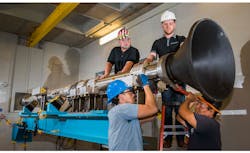Rocket Part Testing Goes Green
Engineers at Sandia National Laboratories successfully demonstrated a new, more environmentally friendly method to test a rocket part to ensure its avionics would withstand the shock from stage separation during flight.
The new method, called the Alternative Pyroshock Test, used a nitrogen-powered gas gun to shoot a 100-lb steel projectile into a resonant steel beam, which then transfers energy through a resonant cone attached to the part being tested. The resulting energy transfer mimics conditions of stage separation in space. The first test of this type using the flight hardware was completed this spring.
According to mechanical engineer Mark Pilcher, pyroshock tests conducted to ensure aerospace parts were ready for the rigors of flight traditionally used explosives encased in lead to provide the impacts to parts needed.
The lead and explosives were environmental hazards, so cleanup was costly and time-consuming. The Sandia Labs team wanted a better approach.
When asked to research whether an alternative means of testing was possible using a gas gun, Sandia mechanical engineer Bo Song turned to a 1-in.-diameter Hopkinson bar. The Hopkinson bar was first used in 1914 by Bertram Hopkinson, a British patent lawyer and Cambridge University professor of mechanism and applied mechanics, as a way to measure the pressure created by explosives. It was further modified in 1949 for dynamic stress-strain measurements of materials.
At Sandia, Song and his team conducted small-scale testing with a metal rod about 20 times smaller than what would be used in full-scale tests. They discovered the Hopkinson bar could provide the frequency levels and mechanical energy needed in the large-scale test to recreate flight conditions.
Song’s team conducted more than 50 tests. The researchers looked at what types of projectiles to use, how fast the gas gun needed to shoot, how to design a Hopkinson bar-type apparatus called a resonant bar at a larger scale, how to design a steel resonant cone to transfer the energy to the object being tested, and how to manipulate the pulse of energy using small copper “coins” called programmers or pulse shapers, which were placed on the surface of the resonant bar.
“The most difficult part was designing the programmers, or pulse shapers, because we had to select the right material, geometry and dimensions,” Song said. “We got a lot of experience through this kind of testing for the future large-scale testing.
“The same concept can be used for a variety of defense and space applications,” he added. “This provides a new path for pyroshock testing, but very clean and more controllable, and [it] will reduce or eliminate a lot of costs.”
In the next phase of the project, the Hopkinson bar was used with a pneumatically driven gas gun. For this test, the gas gun was not required to reach its maximum capacities. The 60-foot-long gun used compressed nitrogen gas to shoot metal projectiles into a resonant beam coupled with a resonant cone to expand the final diameter to connect to the rocket part, essentially a hybrid version of a large-scale Hopkinson bar. Typically the bar and test objects are small, but in this case, researchers used a 1,500-lb, 8-ft.-long, 8-in. diameter bar.
Like a musical tuning fork, the resonant bar and resonant cone needed to vibrate at certain frequencies to apply the right amount of energy to the test object.
Ahead of the final tests, Barnes’ team used an empty mock test object outfitted with accelerometers to measure the impact. Barnes changed the geometry and composition of the programmers to simulate the test conditions required for the program.
Now that Sandia has put in analysis and testing, future tests of this sort should require less development and cost less. “Ideally, we can create a repeatable environment,” Barnes said, “something we can dial in, so if they need to do this test again in the future, we can build this back up and start testing.”

